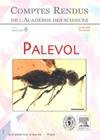晚中新世类人猿 Ouranopithecus macedoniensis (Bonis, Bouvrain, Geraads & Melentis, 1974):上颌乳牙和未拔除恒牙的虚拟重建
IF 1.3
4区 地球科学
Q3 PALEONTOLOGY
引用次数: 0
摘要
原始人马其顿乌古猿(Bonis, Bouvrain, Geraads &Melentis, 1974)在希腊的三个晚中新世地区被发现。均与晚瓦利西亚期有关,MN10;更准确地说,它们的年代在9.6到8.7 Ma之间。在过去的50年里,这种人科动物的一些化石已经被发现。本文描述了在希腊马其顿阿克索斯山谷的Ravin de la Pluie地区发现的第一个具有上乳牙的标本。O. macedoniensis的上乳牙列的特征是相对于乳牙前臼齿的长度而言犬齿较小,具有圆形的咬合冠轮廓,具有后锥体和初级下锥体的梯形dP3,亚方形dP4和缺乏带。研究材料的分类和性别归属是基于保存和虚拟重建的永久牙列,使用高分辨率微计算机断层扫描。通过与现有的O. macedoniensis样本的形态学和测量比较,以及Ravin de la Pluie样本的单特异性特征和强烈的性别二态性,可以将其归属于该分类单元的一个女性亚成年个体。马其顿Ouranopithecus macedoniensis的上乳齿保留了一些形态特征,这可能具有系统发育价值,但由于所有化石分类群的可用材料都很差,这一假设需要进一步研究。本文章由计算机程序翻译,如有差异,请以英文原文为准。
The Late Miocene hominoid Ouranopithecus macedoniensis (Bonis, Bouvrain, Geraads & Melentis, 1974): maxillary deciduous dentition and virtual reconstruction of the unerupted permanent teeth
The hominoid Ouranopithecus macedoniensis (Bonis, Bouvrain, Geraads & Melentis, 1974) is known from three Late Miocene localities in Greece. All are correlated with late Vallesian, MN10; more precisely, they are dated between 9.6 and 8.7 Ma. During the last 50 years several fossils of this hominoid have been recovered. The present article describes the first specimen with upper deciduous teeth, recovered from the locality Ravin de la Pluie in Axios Valley (Macedonia, Greece). The upper deciduous dentition of O. macedoniensis is characterised by a small canine relative to the length of the deciduous premolars, with a rounded occlusal crown outline, a trapezoidal dP3 with metacone and a rudimentary hypocone, a sub-squared dP4, and the absence of cingulum. The taxonomic and sexual attribution of the studied material is based on the preserved and virtually reconstructed permanent dentition, using high resolution microcomputed tomography. The morphological and metrical comparisons of the permanent dentition with the available sample of O. macedoniensis, as well as the monospecific character and the strong sexual dimorphism of the Ravin de la Pluie sample, allow its attribution to a female sub-adult individual of this taxon. The upper deciduous teeth of Ouranopithecus macedoniensis preserve some morphological features, that may have a phylogenetic value, but this hypothesis requires further investigation as the available material of all fossil taxa is poor.
求助全文
通过发布文献求助,成功后即可免费获取论文全文。
去求助
来源期刊

Comptes Rendus Palevol
地学-古生物学
CiteScore
2.10
自引率
0.00%
发文量
39
审稿时长
17.6 weeks
期刊介绍:
Comptes Rendus Palevol is a fully electronic and peer-reviewed journal, with a continuous publication stream, devoted to palaeontology, prehistory and evolutionary sciences. It publishes original research results, in French or English, in the following domains: systematic and human palaeontology, prehistory, evolutionary biology and macroevolution, and history of sciences. Thematic issues may also be published under the responsibility of a guest editor. All articles published in Comptes Rendus Palevol are compliant with the different nomenclatural codes. A copyright assignment will be signed by the authors before publication.
 求助内容:
求助内容: 应助结果提醒方式:
应助结果提醒方式:


